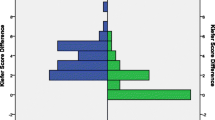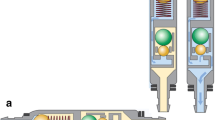Abstract
Objective
Overdrainage in children is a long-term problem for shunted patients which might lead to chronic anatomical changes. In order to prevent these problems, valve exchange is performed on a regular basis in patients without hydrostatic units towards a valve with both an adjustable and a gravitational unit. The clinical outcome of these patients is reported in a retrospective study.
Methods
Between 2009 and 2014, the in-house database was analyzed for patients who received a valve exchange towards an adjustable differential pressure valve with gravitational unit. The study protocol included the patients shunt history, image analysis for ventricular width, and necessity of revision surgery after valve exchange. A questionnaire was sent to the patients in order to ask for their subjective experience for symptom changes and treatment experience.
Results
Forty-six patients were identified (26 girls, mean age 11.8 ± 6.1 years) with a mean follow-up of 36.3 ± 15 months. The ventricular width did increase after valve exchange as measured in frontal and occipital horn ratio (0.364 ± 0.032 vs. 0.402 ± 0.09, p = 0.0017). Of the patients suffering from acute symptoms, 89% improved after treatment. The shunt and valve survival rates were 88 and 95%, respectively, after 12 months. Comparing the total amount of revisions before and after valve exchange, a significant reduction was seen in total but a no significant difference was analyzed in amount of revisions to time ratio.
Conclusion
Valve exchange might be cautiously decided if patients seem to perform clinically well. In our study, we were able to show that the strategy of valve exchange to prevent chronic overdrainage is well tolerated and seem to improve patient’s clinical outcome in terms of ventricular width, symptom relieve, and revision rate.


Similar content being viewed by others
References
Drake JM, Kestle JR, Tuli S (2000) CSF shunts 50 years on—past, present and future. Childs Nerv Syst 16:800–804
Boockvar JA, Loudon W, Sutton LN (2001) Development of the Spitz-Holter valve in Philadelphia. J Neurosurg 95:145–147
Browd SR, Gottfried ON, Ragel BT, Kestle JR (2006a) Failure of cerebrospinal fluid shunts: part II: overdrainage, loculation, and abdominal complications. Pediatr Neurol 34:171–176
Rekate HL (2008) Shunt-related headaches: the slit ventricle syndromes. Childs Nerv Syst 24:423–430
Freimann FB, Sprung C (2012) Shunting with gravitational valves—can adjustments end the era of revisions for overdrainage-related events?: clinical article. J Neurosurg 117:1197–1204
Gruber RW, Roehrig B (2010) Prevention of ventricular catheter obstruction and slit ventricle syndrome by the prophylactic use of the Integra antisiphon device in shunt therapy for pediatric hypertensive hydrocephalus: a 25-year follow-up study. J Neurosurg Pediatr 5:4–16
Faulhauer K, Schmitz P (1978) Overdrainage phenomena in shunt treated hydrocephalus. Acta Neurochir 45:89–101
Pudenz RH, Foltz EL (1991) Hydrocephalus: overdrainage by ventricular shunts. A review and recommendations. Surg Neurol 35:200–212
Thomale UW, Gebert AF, Haberl H, Schulz M (2013a) Shunt survival rates by using the adjustable differential pressure valve combined with a gravitational unit (proGAV) in pediatric neurosurgery. Childs Nerv Syst 29:425–431
Browd SR, Ragel BT, Gottfried ON, Kestle JR (2006b) Failure of cerebrospinal fluid shunts: part I: obstruction and mechanical failure. Pediatr Neurol 34:83–92
Cinalli G, Sainte-Rose C, Kollar EM et al (1998) Hydrocephalus and craniosynostosis. J Neurosurg 88:209–214
Gruber R, Jenny P, Herzog B (1984) Experiences with the anti-siphon device (ASD) in shunt therapy of pediatric hydrocephalus. J Neurosurg 61:156–162
O’Hayon BB, Drake JM, Ossip MG, Tuli S, Clarke M (1998) Frontal and occipital horn ratio: a linear estimate of ventricular size for multiple imaging modalities in pediatric hydrocephalus. Pediatr Neurosurg 29:245–249
Kulkarni AV, Drake JM, Armstrong DC, Dirks PB (1999) Measurement of ventricular size: reliability of the frontal and occipital horn ratio compared to subjective assessment. Pediatr Neurosurg 31:65–70
Jamous M, Sood S, Kumar R, Ham S (2003) Frontal and occipital horn width ratio for the evaluation of small and asymmetrical ventricles. Pediatr Neurosurg 39:17–21
Gebert AF, Schulz M, Haberl H, Thomale UW (2013) Adjustments in gravitational valves for the treatment of childhood hydrocephalus—a retrospective survey. Childs Nerv Syst 29:2019–2025
Rohde V, Haberl EJ, Ludwig H, Thomale UW (2009) First experiences with an adjustable gravitational valve in childhood hydrocephalus. J Neurosurg Pediatr 3:90–93
Sprung C, Schlosser HG, Lemcke J et al (2010) The adjustable proGAV shunt: a prospective safety and reliability multicenter study. Neurosurgery 66:465–474
Toma AK, Tarnaris A, Grieve JP, Watkins LD, Kitchen ND (2010) Adjustable shunt valve-induced magnetic resonance imaging artifact: a comparative study. J Neurosurg 113:74–78
Tuli S, Drake J, Lawless J, Wigg M, Lamberti-Pasculli M (2000) Risk factors for repeated cerebrospinal shunt failures in pediatric patients with hydrocephalus. J Neurosurg 92:31–38
Thomale UW, Knitter T, Schaumann A et al (2013b) Smartphone-assisted guide for the placement of ventricular catheters. Childs Nerv Syst 29:131–139
Reinprecht A, Dietrich W, Bertalanffy A, Czech T (1997) The Medos Hakim programmable valve in the treatment of pediatric hydrocephalus. Childs Nerv Syst 13:588–593 discussion 93-4
Zemack G, Bellner J, Siesjo P, Stromblad LG, Romner B (2003) Clinical experience with the use of a shunt with an adjustable valve in children with hydrocephalus. J Neurosurg 98:471–476
Ahn ES, Bookland M, Carson BS, Weingart JD, Jallo GI (2007) The strata programmable valve for shunt-dependent hydrocephalus: the pediatric experience at a single institution. Childs Nerv Syst 23:297–303
Author information
Authors and Affiliations
Corresponding author
Ethics declarations
Conflict of interest
UWT received lecture honorarium from Aesculap and Miethke companies and has performed consultant activities for Miethke company.
AS received lecture honorarium from Aesculap. All other authors have no conflict of interest to declare.
Rights and permissions
About this article
Cite this article
Alavi, S., Schulz, M., Schaumann, A. et al. Valve exchange towards an adjustable differential pressure valve with gravitational unit, clinical outcome of a single-center study. Childs Nerv Syst 33, 759–765 (2017). https://doi.org/10.1007/s00381-017-3387-0
Received:
Accepted:
Published:
Issue Date:
DOI: https://doi.org/10.1007/s00381-017-3387-0




